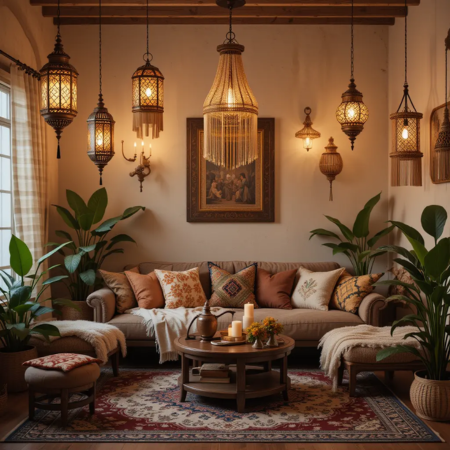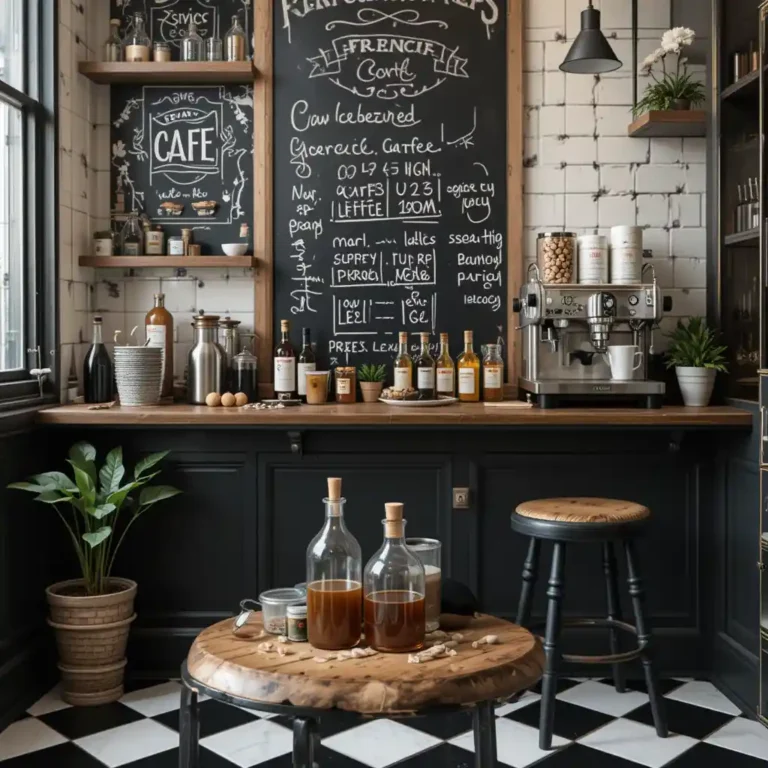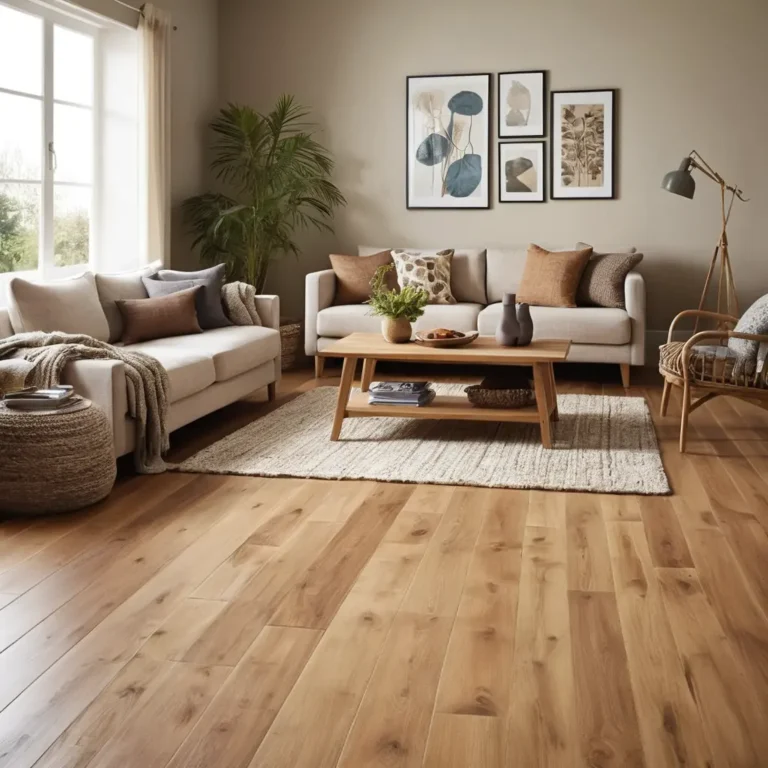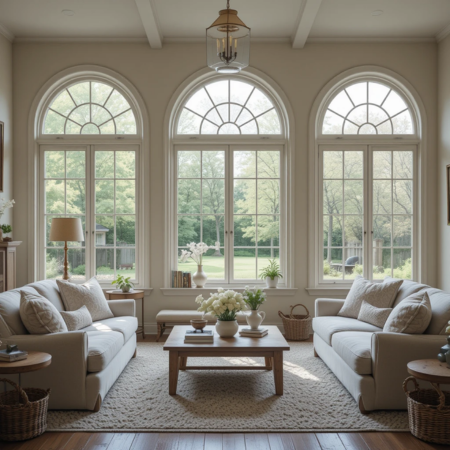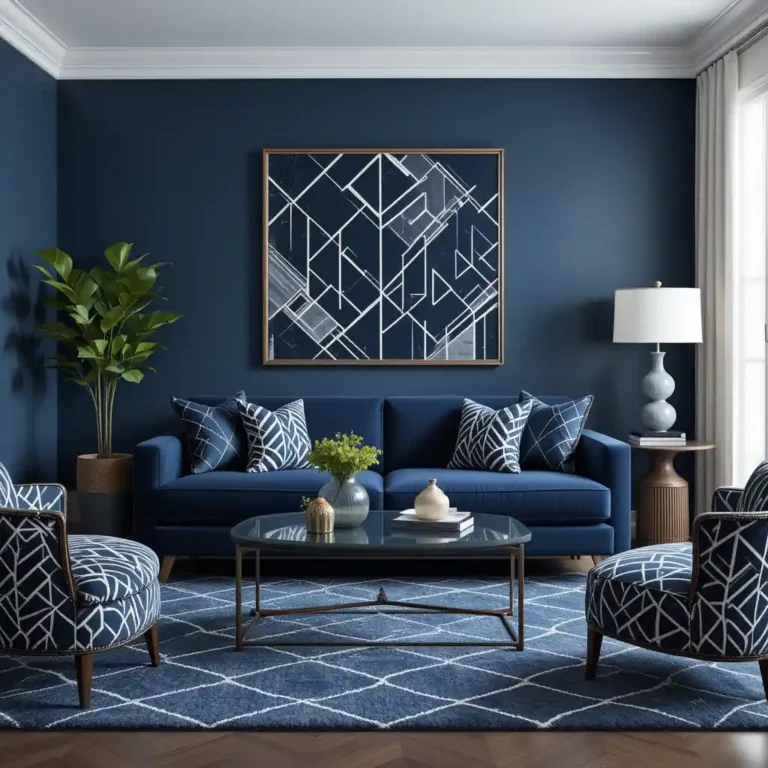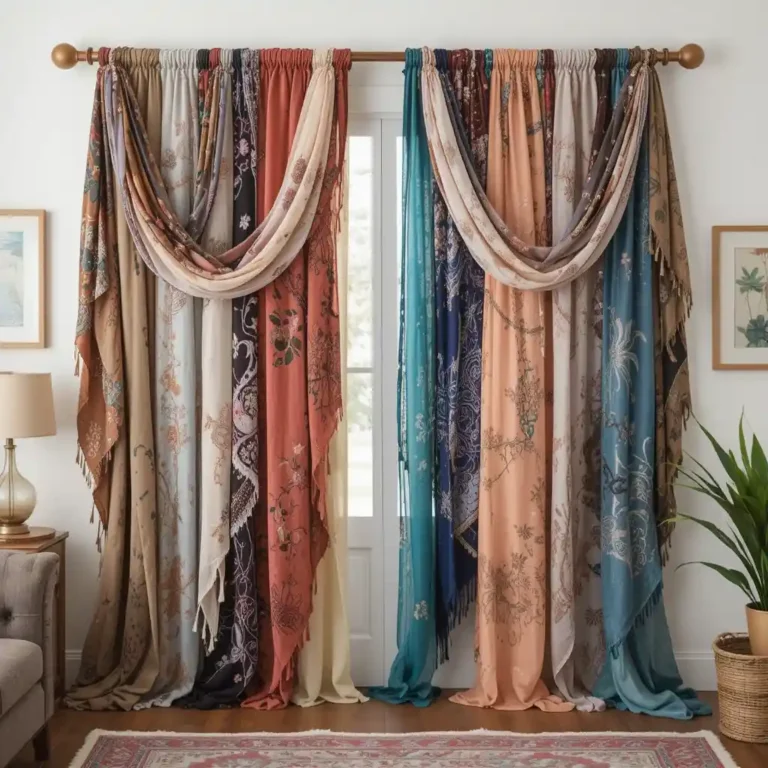58 Brilliant Japandi Living Room Ideas for a Peaceful Retreat
Japandi design, a harmonious blend of Japanese minimalism and Scandinavian functionality, has emerged as a favorite for those seeking simplicity and warmth. This unique fusion emphasizes clean lines, neutral tones, and natural materials, creating a space that’s both calming and functional.
Whether you’re redesigning your living room or looking for subtle inspiration, these 58 Japandi living room ideas will guide you in crafting a serene yet stylish environment.
From furniture arrangements to decor choices, explore a world of inspiration that perfectly balances form and function.
1. Neutral Color Palette with Subtle Earthy Highlights
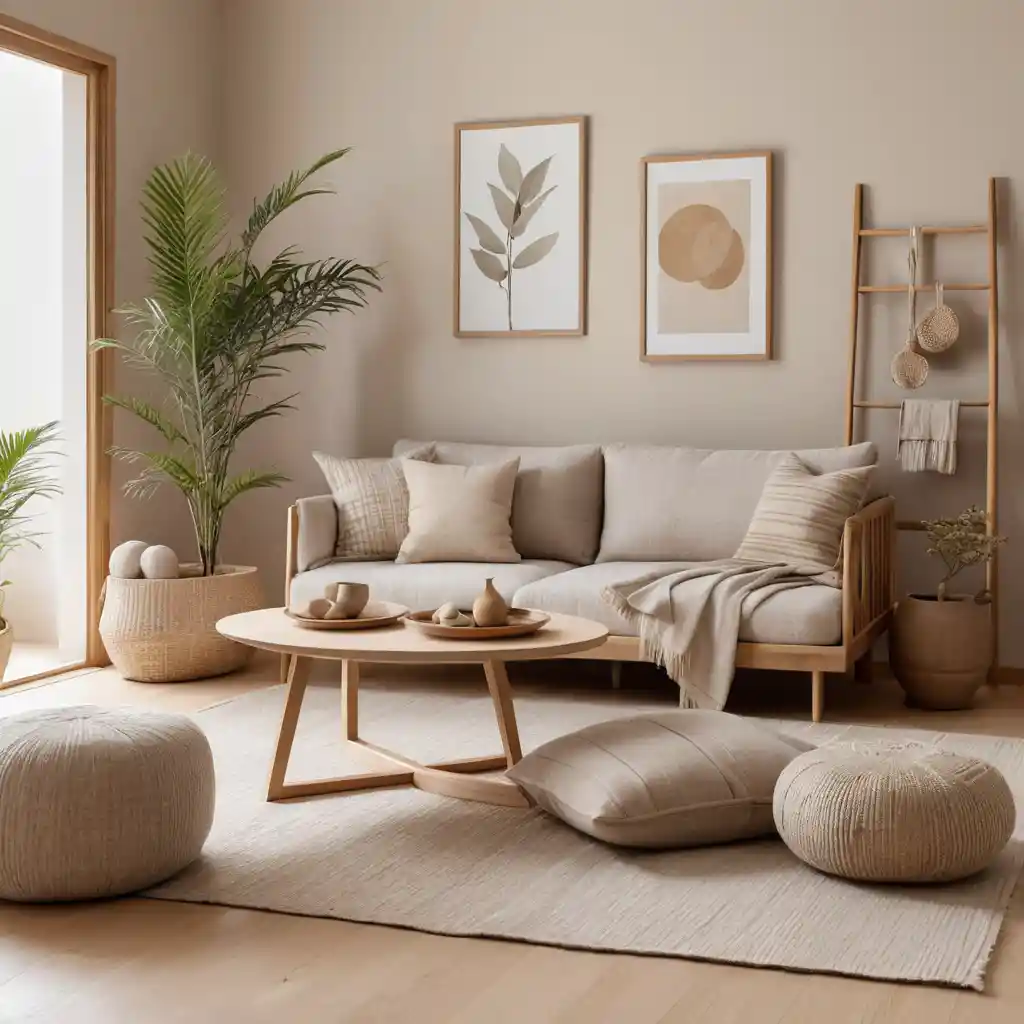
Start with a base of neutral tones like beige, cream, and light gray, and add warmth through wooden furniture or textiles. Opt for soft throws in earthy hues and cushions with subtle patterns to elevate the minimalist vibe without overwhelming the space.
2. Low-profile Furniture

Choose streamlined low-profile furniture such as platform sofas or benches with thin, angular legs. Focus on designs that sit close to the ground but incorporate Scandinavian-inspired upholstery for a balanced aesthetic. This approach avoids duplicating ideas centered on floor cushions or futons.
3. Shoji Screens as Room Dividers

Add a touch of authenticity with Shoji screens to separate areas or create cozy corners. Their light-diffusing panels bring an airy yet private ambiance to your Japandi living room.
4. Natural Wood Elements

Highlight natural wood furniture such as reclaimed oak coffee tables or Japanese-style walnut shelving. Integrate wooden ceiling accents or a bamboo statement wall to add a unique touch while keeping the finishes matte for an understated, organic aesthetic.
5. Minimalist Wall Decor

Stick to simple wall art or leave walls bare to emphasize the minimalistic essence. Consider washi paper art, line drawings, or abstract prints framed in natural wood.
6. Indoor Greenery

Incorporate plants like bonsai, peace lilies, or ferns to bring nature indoors. Choose simple ceramic pots or baskets for a cohesive look.
7. Layered Lighting

Combine natural light with diverse layers, such as adjustable wall sconces, softly glowing paper lanterns, and warm LED strips along shelving. Use this layered approach to create zones of light that feel personalized and versatile, setting it apart from sculptural fixtures or recessed lighting.
8. Tatami Mats for Floor Texture

Enhance the Japandi vibe by adding tatami mats or jute rugs. These bring an authentic Japanese touch while offering the cozy texture favored in Scandinavian interiors.
9. Functional Storage Solutions

Opt for furniture with built-in storage, such as ottomans with compartments or sleek wooden cabinets. This approach keeps the space tidy and reinforces the minimalist design.
10. Balanced Symmetry

Arrange furniture symmetrically for a calming, organized look. For instance, pair a sofa with identical side tables and lamps for visual balance.
11. Soft and Natural Textiles

Choose cotton, linen, or wool for throws, curtains, and cushions. Stick to solid colors or understated patterns like stripes to maintain harmony.
12. Accent with Black Details

Add contrast with black-framed mirrors, metal light fixtures, or vases. These subtle accents ground the light, neutral palette without dominating the design.
13. Open and Airy Layouts

Adopt an open-plan layout to ensure the room feels spacious and uncluttered. Use furniture strategically to define zones without barriers.

Include handmade pottery, wooden bowls, or woven baskets as decor pieces. These items highlight craftsmanship and echo the natural aesthetic of Japandi design.
15. Muted Pastel Accents

Add soft colors like sage green, pale pink, or light blue in cushions or small decor items. These hues subtly brighten the space while adhering to the minimalist palette.
16. Streamlined Shelving

Choose floating shelves or built-in units to display curated items like books, pottery, or small sculptures. Keep displays minimal to avoid visual clutter.
17. Statement Pendant Lighting

A single, oversized pendant light with a natural material like bamboo or rattan serves as both a focal point and a source of warmth in the living room.
18. Textured Walls with Lime Wash

Use lime wash paint for a textured, earthy wall finish. Its subtle variations add depth while keeping the look understated.
19. Floor-to-Ceiling Windows

If possible, embrace natural light with large windows. Use sheer curtains to diffuse sunlight while maintaining privacy.
20. Wabi-sabi-Inspired Decor

Incorporate the Japanese philosophy of wabi-sabi by choosing decor that celebrates imperfections, such as hand-thrown pottery or reclaimed wood pieces.

Choose a minimalist Scandinavian coffee table with clean lines, a light wood finish, and functional storage options. Pair it with soft rugs for a cozy feel.
22. Zen-inspired Corners

Designate a quiet corner with a simple floor cushion, a low table, and a plant or candle. This Zen space is perfect for reading or meditation.
23. Textured Throw Pillows

Use throw pillows with woven or quilted textures to add visual interest. Stick to neutral or earthy colors to maintain the Japandi aesthetic.
24. Stone Accents

Incorporate stone elements, such as a basalt side table or a limestone vase. These natural materials add a grounding presence to the room.
25. Monochromatic Layers

Layer different shades of the same color for a cohesive look. For instance, combine off-white walls, beige furniture, and cream accents for a unified palette.
26. Sliding Wood Panel Doors

Replace traditional doors with sliding wood panels. They’re functional, save space, and add a distinct Japanese aesthetic.
27. Sculptural Lighting Fixtures

Incorporate sculptural light fixtures with organic shapes to create focal points. Choose materials like wood or ceramic for a natural feel.
28. Geometric Rugs

Add a rug with subtle geometric patterns to bring a hint of modernity while still maintaining the minimalist approach.
29. Bamboo Blinds

Swap heavy curtains for bamboo blinds. They’re lightweight, natural, and allow filtered light to flow through.
30. Japanese Ceramics on Display

Showcase handmade Japanese ceramics on open shelves or as centerpieces. Their natural textures and earthy tones add an artisanal touch.
31. Linen Slipcovers for Furniture

Opt for linen slipcovers to give furniture a relaxed yet polished look. The breathable fabric enhances the minimalist vibe.
32. Recessed Lighting

Install recessed lights to create a soft, diffused glow. Position them strategically to highlight key areas without overpowering the space.
33. Asymmetrical Layouts

Experiment with asymmetry in furniture placement for a dynamic, lived-in feel. For instance, offset a sofa with an oversized plant.
34. Low-profile Bookshelves

Choose low bookshelves to maintain an open feel. Display a curated selection of books and decor to avoid overcrowding.
35. Clay Vases with Dried Flowers

Use clay vases filled with dried pampas grass or branches. These natural elements add height and texture to the room.
36. Modular Furniture

Invest in modular pieces like sectional sofas or stackable stools. They’re flexible and ideal for Japandi’s functional ethos.
37. Dark Wood Accents

Add contrast with dark wood furniture or decor elements. Pair them with lighter tones for a balanced look.
38. Open Ceiling Beams

Expose wooden ceiling beams to emphasize natural materials and create architectural interest in the living room.
40. Minimalist Media Console

Opt for a sleek, wooden media console with hidden storage. Its simplicity complements the overall Japandi style.
41. Abstract Wall Hangings

Decorate with abstract fabric wall hangings in neutral tones. These add texture and movement to bare walls.
42. Linen Roman Shades

Use Roman shades in linen fabric for a tailored, minimalist window treatment. They’re practical and understated.
43. Exposed Brick Accent Wall

If possible, highlight an exposed brick wall for added texture. Keep it painted white or natural for a Japandi twist.
44. Nesting Tables

Incorporate nesting tables made of wood or metal. They’re versatile and blend seamlessly with the Japandi aesthetic.
45. Curved Furniture Shapes

Choose curved sofas or chairs to soften the room’s lines. Their organic shapes bring comfort and visual interest.
46. Charcoal Gray Accents

Introduce charcoal gray in rugs, pillows, or small furniture pieces to add depth without overpowering the neutral palette.
47. Japanese Lanterns

Hang traditional Japanese lanterns to illuminate the space with a warm, diffuse light. Their iconic shapes are timeless.
48. Layered Window Treatments

Combine sheer curtains with bamboo blinds for a layered effect. This approach balances light control with privacy.
49. Hidden Storage Benches

Use benches with hidden storage for functionality. They double as seating and help maintain the minimalist aesthetic.
50. Artisanal Woven Decor

Incorporate woven wall hangings or baskets to add handcrafted details that echo both Japanese and Scandinavian traditions.
51. Subtle Metallic Accents

Add small metallic elements like brass candlesticks or copper bowls to introduce a touch of understated luxury.
52. Built-in Seating

Create built-in benches or seating areas along walls. Add cushions for comfort while maintaining a clean, cohesive look.
53. Black and White Contrast

Play with black and white accents for a bold yet minimalist contrast. Use black frames or white ceramics to emphasize balance.
54. Textured Ceiling Panels

Consider wood-paneled ceilings or textured plaster finishes to add subtle interest overhead while maintaining simplicity.
55. Handwoven Rugs

Place handwoven rugs under furniture for texture and warmth. Choose patterns inspired by nature for authenticity.
56. Built-in Niches

Add built-in wall niches to display decor or books. Light them with recessed fixtures for a soft glow.
57. Driftwood Decor

Incorporate driftwood pieces as sculptures or table centerpieces. Their natural, organic shapes tie the room to nature.
58. Multi-functional Daybeds

Use a daybed that functions as both seating and lounging space. Choose a minimalist design with neutral upholstery.
Conclusion
Crafting a Japandi living room is about striking the perfect balance between simplicity and comfort, minimalism and warmth.
By combining Scandinavian functionality with Japanese elegance, you can create a space that feels both modern and timeless.
Whether you’re drawn to natural materials, muted tones, or the philosophy of less-is-more, these ideas will inspire a serene retreat that aligns with the principles of Japandi design.
Begin your transformation today and experience the beauty of this harmonious style.
Contents
- 1. Neutral Color Palette with Subtle Earthy Highlights
- 2. Low-profile Furniture
- 3. Shoji Screens as Room Dividers
- 4. Natural Wood Elements
- 5. Minimalist Wall Decor
- 6. Indoor Greenery
- 7. Layered Lighting
- 8. Tatami Mats for Floor Texture
- 9. Functional Storage Solutions
- 10. Balanced Symmetry
- 11. Soft and Natural Textiles
- 12. Accent with Black Details
- 13. Open and Airy Layouts
- 14. Rustic Scandinavian Accessories
- 15. Muted Pastel Accents
- 16. Streamlined Shelving
- 17. Statement Pendant Lighting
- 18. Textured Walls with Lime Wash
- 19. Floor-to-Ceiling Windows
- 20. Wabi-sabi-Inspired Decor
- 21. Scandinavian-Inspired Coffee Tables
- 22. Zen-inspired Corners
- 23. Textured Throw Pillows
- 24. Stone Accents
- 25. Monochromatic Layers
- 26. Sliding Wood Panel Doors
- 27. Sculptural Lighting Fixtures
- 28. Geometric Rugs
- 29. Bamboo Blinds
- 30. Japanese Ceramics on Display
- 31. Linen Slipcovers for Furniture
- 32. Recessed Lighting
- 33. Asymmetrical Layouts
- 34. Low-profile Bookshelves
- 35. Clay Vases with Dried Flowers
- 36. Modular Furniture
- 37. Dark Wood Accents
- 38. Open Ceiling Beams
- 40. Minimalist Media Console
- 41. Abstract Wall Hangings
- 42. Linen Roman Shades
- 43. Exposed Brick Accent Wall
- 44. Nesting Tables
- 45. Curved Furniture Shapes
- 46. Charcoal Gray Accents
- 47. Japanese Lanterns
- 48. Layered Window Treatments
- 49. Hidden Storage Benches
- 50. Artisanal Woven Decor
- 51. Subtle Metallic Accents
- 52. Built-in Seating
- 53. Black and White Contrast
- 54. Textured Ceiling Panels
- 55. Handwoven Rugs
- 56. Built-in Niches
- 57. Driftwood Decor
- 58. Multi-functional Daybeds

